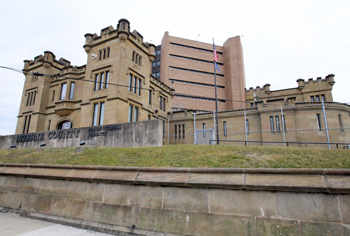Luzerne County Reignites Talk of New Prison
 WILKES-BARRE, Pa. — Luzerne County Manager Robert Lawton proposed exploring the feasibility of a new Luzerne County Correctional Facility, a formerly unsuccessful plan that cost the county $2.5 million in planning and design in 2006.
WILKES-BARRE, Pa. — Luzerne County Manager Robert Lawton proposed exploring the feasibility of a new Luzerne County Correctional Facility, a formerly unsuccessful plan that cost the county $2.5 million in planning and design in 2006.
Lawton suggested hiring an independent consultant in February during his “state of the county” report to county councilors in considering the replacement of the aging Wilkes-Barre prison.
“I think we’re certainly in desperate need of a new prison,” said Deputy Warden James Larson. “We’re short of cell space, we’re short of everything to be honest with you.”
Space for programs such as Narcotics Anonymous and Alcoholics anonymous is limited, Larson said, and inmate-attorney conversations can be a frustrating situation.
“We only have three interview rooms,” Larson said. “So sometimes attorneys will be backed up in a line around the prison.”
Surrounded by the original mid-19th century prison, the five-story 650-inmate tower prison was built in 1987. Because of its layout, Larson said, programs and operations are spread throughout the antiquated facility.
“Everything’s just pigeon holed in different areas,” Larson said.
According to the county manager, the plan is very much still in the preliminary stages.
“I will be moving forward on this next year in terms of look at efficiencies to be gained,” Lawton said. “We’ll try and flush this thing out, but it may just disappear as quickly as it came.”
Lawton stated in his report that a new prison would require fewer guards and reduce maintenance costs, which could cover the costs of building a new facility. A 2009 report from independent investors Public Financial Management expected the cost of a 1,000-bed prison to be approximately $100 million.
In 2006, the county council approved a $2.5 million design contract for a 1,500-bed prison with L. Robert Kimball and Associates. The plan was halted in 2008 when a location was never chosen.
According to councilman James Bobeck, the city is taking more caution with the plans this time around.
“Unlike 2008, the current plan also includes a review of current operations to determine better practices not contingent on building a new facility, along with the feasibility of a new prison,” Bobeck said. “Also, at this point, we want to determine simply the amount a new prison can cost, possible funding sources through our capital expenditure fund, but not at this point commit to a costly design layout as prior commissioners did in 2008.”
Bobeck, along with council members Elaine Maddon Curry and Rick Williams, expressed support for Lawton’s plan to investigate feasibility.
“We know our current facility has outlived its shelf life, and we need to start examining our future and investing in necessary changes instead of maintaining inefficiencies,” Bobeck said.
The idea has also spurred opposition from city council members, specifically councilman Stephen A. Urban, who has said the city simply does not have the funds or the bonding capability to take on such a project.
“I know intuitively that there are savings to be gained,” Lawton said. “The question is whether or not the savings I can substantiate are sufficient to fully advertise the capital cost of the facility.”
If executed with financial and operational efficiency, Bobeck said a new prison would benefit inmates, prison staff and the community.
“If the county can build a new facility, we can have better oversight over our prison population, cut down on prisoner-related violence on other inmates, guards, and also cut down on staffing costs with a better layout for monitoring, which will prevent throwing further money away by funding our current inefficient practices that result from maintaining a subpar facility,” Bobeck said.

